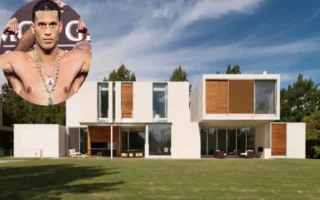John Lautner, a name synonymous with innovative architecture, is celebrated for his ability to create structures that harmoniously integrate with their surroundings. One of his most remarkable masterpieces is the Arango House, a stunning example of how architecture can reflect and enhance the natural beauty of its environment.
| Attribute | Details | Source |
|---|---|---|
| Name | Jerónimo Julio Arango Arias | |
| Personal Info | Mexican businessman, co-founder of the Aurrerá supermarket chain, part of family retail empire | |
| Net Worth | Estimated around $4.4 to $4.6 billion USD at peak | |
| Current Residence | Deceased April 4, 2020; prior residence in Los Angeles, California | |
| Arango House | Also known as Marbrisa House, designed by John Lautner in early 1970s as family weekend home in Acapulco, Mexico | |
| Ownership of House | The Arango family still owns the Arango House (Marbrisa House) |
The Vision Behind the Arango House
The Commission and Background
In 1970, Jeronimo Arango, a prominent Mexican businessman, commissioned Lautner to design a weekend retreat that would capture the essence of its breathtaking surroundings. Arango envisioned a space where he could escape the hustle and bustle of city life, a place that blended comfort with nature.
Inspiration from Nature
Lautner was deeply inspired by the natural features of the site, particularly the stunning views of the ocean and sky. This inspiration led him to create a design that not only respected the landscape but also enhanced it. The Arango House became a canvas for Lautner’s architectural philosophy, mirroring elements of his previous works, like the famed Elrod House in Palm Springs.
Architectural Design and Features
A Unique Architectural Style
The Arango House stands out for its futuristic and organic architectural style. It embodies the spirit of mid-century modern design, characterised by clean lines, open spaces, and a seamless connection between indoor and outdoor living.
The Concrete Structure
Constructed primarily from concrete, the house presents several engineering challenges that Lautner expertly navigated. The two-floor layout features an open terrace above, serving as a gathering space, while the living and sleeping quarters reside below.
The Cantilevered Moat/Pool
One of the house’s most striking features is the cantilevered moat/pool that surrounds the terrace. This design element not only enhances the aesthetic appeal but also serves a functional purpose, allowing for cooling breezes to circulate throughout the home.
Blending with Nature
| Aspect | Details |
|---|---|
| House Name | Arango House (also known as Casa Marbrisa, Arango Residence) |
| Architect | John Lautner (with collaboration from Helena Arahuete) |
| Location | 1a. Cda. Vientos Cardinales, Las Brisas, 39867 Acapulco, Guerrero, Mexico |
| Commissioned by | Jerónimo Arango, Mexican entrepreneur |
| Year Commissioned | 1970 |
| Year Completed | 1973 |
| Size/Floor Area | Approximately 2,300 square meters (about 25,000 square feet) |
| Floors | Two floors |
| Architectural Style | Organic architecture inspired by natural features of the site, ocean and sky; mid-century modern |
| Design Highlights | – Concrete structure with bold, curving, sculptural concrete forms |
| – Perched on a steep mountainside above Acapulco Bay, giving panoramic ocean views | |
| – Large open terrace on upper floor with a cantilevered moat pool surrounding the terrace | |
| – Water moat integrated into terrace, deep and wide enough for swimming | |
| – The terrace floor is unpolished marble; roof supported by slender columns | |
| – Use of natural materials like stone and glass, with rocky terrain integrated into bedroom walls | |
| – Monumental bronze entrance door designed by Mathias Goeritz | |
| – The house seems to float between sea and sky | |
| Address | Near Inmobiliaria Monifer S.A., 1a. Cda. Vientos Cardinales S/n, Las Brisas, Acapulco |
| Owner | Still owned by the Arango family |
| Purpose | Originally a weekend and vacation home for Arango family |
| Significance | Considered one of the most iconic and extraordinary homes of the 20th century; Lautner’s only house in Mexico |
| Construction Details | Concrete, stone, glass; reinforced with innovations pioneered by engineer T.Y. Lin |
| Worth | Not publicly disclosed; considered architecturally invaluable due to design and legacy |
| Historical Note | Inspired by the Elrod House; selected site for dramatic views over Acapulco Bay; completed in under a year |
| Recognition | Ranked by Architectural Record magazine in 1977 as “a party space mixing room, sea, and sky” |
The Arango House uniquely blends indoor living with the natural environment. With panoramic views of Acapulco Bay, it appears to float above the landscape, providing a tranquil escape that invites the beauty of nature inside.
The Structure and Engineering Marvel
The Fan-Shaped Roof
At the heart of the Arango House is its iconic fan-shaped concrete roof, which is considered the largest and most daring structure Lautner designed. This architectural marvel allows for expansive open living spaces while minimising the need for support pillars.
Integration with the Landscape
Lautner’s design philosophy is evident in the integration of natural rock and the surrounding landscape into the structure. This connection not only enhances the aesthetic appeal of the house but also reinforces its relationship with the environment.
Pushing Engineering Boundaries
The materials and architectural innovations employed in the Arango House pushed the boundaries of engineering in the 1970s. Lautner’s approach to design was not just about aesthetics; it was about creating a functional space that harmonised with its surroundings.
Interiors and Living Experience
Open-Air Living Spaces
The interior design of the Arango House is a testament to Lautner’s vision of open-air living. Each space is crafted to invite the outdoors in, with large windows and open layouts that maximise natural light.
Unique Features
The bedrooms and bathrooms within the house are designed with comfort and luxury in mind. One standout feature is the jacuzzi that overlooks the bay, offering a serene space for relaxation.
Collaborations in Design
Lautner collaborated with talented interior designers, including Arthur Elrod, to create furniture and interior details that complement the architectural vision of the Arango House. This collaboration resulted in a cohesive design that enhances the overall living experience.
The Location: Acapulco and the Surrounding Environment
Geographic Setting
Situated on a hillside overlooking Acapulco Bay, the Arango House is perfectly positioned to take advantage of the stunning views. The site’s natural beauty greatly influenced Lautner’s design choices, making the location an integral part of the home’s identity.
Climate Considerations
The warm climate of Acapulco played a significant role in the architectural decisions made for the Arango House. Lautner designed the house to maximise airflow and natural cooling, ensuring a comfortable living environment.
Harmony with Nature
The relationship between the Arango House and its surroundings is a harmonious blend of water, sky, and landscape. Lautner’s design philosophy emphasises a connection with nature, creating a space that feels both inviting and serene.
Legacy and Cultural Significance
An Iconic Landmark
The Arango House is not just a home; it represents a significant milestone in modern architecture. As Lautner’s only project in Mexico, it holds a special place in architectural history and continues to inspire architects and enthusiasts worldwide.
Influence on Modern Architecture
The house’s innovative design and engineering have influenced countless designers and architects. It serves as a case study in how to blend aesthetics with functionality, making it a sought-after example of organic architecture.
Preservation and Ownership
The continued ownership of the Arango House by the Arango family has allowed for its preservation and appreciation. Their commitment to maintaining the property ensures that this architectural gem remains a part of Mexico’s cultural heritage.
Visiting and Experiencing the Arango House
Public Access and Tours
While the Arango House is primarily a private residence, there are opportunities for architectural tours and photographic studies. These experiences provide a unique insight into Lautner’s design philosophy and the house’s stunning features.
Importance for Architecture Enthusiasts
For architecture students, historians, and enthusiasts, the Arango House is a vital resource for understanding modern architectural principles. Its design and construction offer invaluable lessons in integrating nature with living spaces.
John Lautner: The Architectural Genius Behind the Arango House
Biography and Design Philosophy
John Lautner was an architectural visionary known for his belief in creating spaces that resonate with their environment. His philosophy focused on integrating architecture with nature, and the Arango House is a prime example of this approach.
Collaboration in Design
Lautner’s collaboration with skilled interior designers and engineers further enhanced the Arango House. The collective effort resulted in a masterpiece that reflects his innovative spirit and respect for the environment.
Where Does Arango House Currently Live?
Arango House, also known as the Arango Marbrisa House, currently stands in Acapulco, Mexico. It is located at 1a. Cda. Vientos Cardinales, Las Brisas, Marbrisa, overlooking Acapulco Bay. The house was designed by architect John Lautner and built between 1971 and 1973 as a vacation retreat for Jeronimo Arango, a Mexican supermarket magnate.
The house remains in this location, perched on a hilltop site with panoramic views of the Pacific Ocean and Acapulco Bay. It is famous for its organic, curving concrete roof structure and open living spaces that blend indoor and outdoor living seamlessly.






